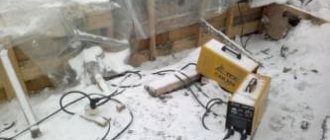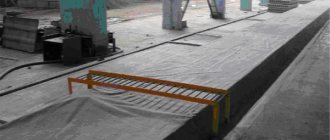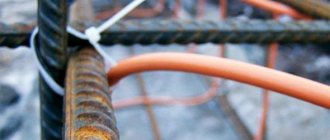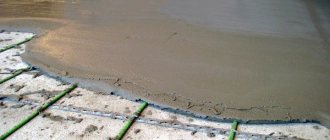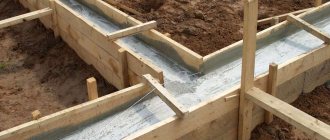Negative air temperatures are not a reason for downtime. Warming up the concrete mixture will help to obtain a material of brand strength. Construction work is carried out all year round. One of the main problems of winter construction is concreting.
Due to exposure to low temperatures, the hydration process in the concrete mixture may be interrupted, which will lead to a breakdown in the strength of the finished material. Therefore, warming up concrete in winter is a necessary and important point.
Features of winter concreting
Is it possible to pour concrete in winter without heating? Experts say it is possible, but risky. Temperature is critical for concrete to gain strength. If a freshly laid concrete mass freezes, the water that has not reacted with the cement will turn into ice. This will lead to an increase in internal pressure. The fragile concrete structure will begin to collapse.
In the future, the ice may melt and the hydration process will resume, but the material will no longer gain the required strength.
To speed up the interaction of the components of the concrete mixture in winter, it is necessary to create and maintain optimal temperature conditions. To do this, you need to know how to warm up concrete in winter.
Many methods are proposed for solving such a problem. Their use is carried out in accordance with the approved rules: SNiP 3.06.04-91, SNiP 3.03.01-87.
Application
Warming up concrete in winter with a cable makes it possible to solve two main problems. At temperatures below zero, the water in the solution turns into ice crystals, and as a result, the cement hydration reaction not only slows down, it stops completely. It is known that when water freezes, it expands, destroying the bonds formed in the solution, so after increasing the temperature it will no longer gain the required strength.
The solution hardens at optimal speed and maintains characteristics at a temperature of about 20°C. As temperatures drop, especially below freezing, these processes slow down, even though hydration produces additional heat. In order to meet technical conditions, in winter it is impossible to do without heating the concrete with a PNSV wire or another cable intended for this purpose in situations where:
- sufficient thermal insulation of the monolith and formwork is not provided;
- the monolith is too massive, which makes it difficult to heat it evenly;
- low ambient temperature at which water in solution freezes.
Concrete heating temperature in winter
For each facility, a technological map is developed for heating using the selected method. The document indicates all technical and economic indicators, including heating temperature.
To correctly determine the temperature regime, many factors should be taken into account. Therefore, in each specific case, the operating temperature values will be individual.
However, according to SNiP, they should not exceed 80⁰С. At the end of the heat treatment, the cooling rate should be no more than 5⁰C per hour.
Careful temperature control is required during operation. The temperature is checked every half hour during the heating period, once every 12 hours during the cooling stage.
Wire characteristics
The cable for heating concrete PNSV consists of a steel core with a cross-section from 0.6 to 4 mm², and a diameter from 1.2 mm to 3 mm. Some types are galvanized to reduce the impact of aggressive components in mortars. Additionally, it is covered with heat-resistant polyvinyl chloride (PVC) or polyester insulation; it is not afraid of kinks, abrasion, aggressive environments, is durable and has high resistivity. The PNSV cable has the following technical characteristics:
- The resistivity is 0.15 Ohm/m;
- Stable operation in the temperature range from -60°C to +50°C;
- Up to 60 m of wire is consumed per 1 cubic meter of concrete;
- Can be used at temperatures down to -25°C;
- Installation at temperatures down to -15°C.
The cable is connected to the cold ends through an aluminum autorecloser wire. Power can be supplied via a three-phase 380 V network by connecting to a transformer. With proper calculation, the PNSV can also be connected to a 220-volt household network; the length should not be less than 120 m. An operating current of 14-16 A should flow through the system located in the concrete mass.
Selection of heat treatment method
Warming up the concrete ensures a maximum rate of strength gain, upon reaching which the formwork can be removed and the structure loaded.
When choosing the most effective method of heat treatment of concrete and heating mode, several factors are taken into account:
- concreting method;
- massive structure;
- air temperature and wind speed;
- available thermal insulation materials and equipment;
- availability of an energy source.
- object dimensions;
- required terms of work;
- economic feasibility.
When using the thermos method, hardening occurs slowly, under the influence of the exothermic heat of hydration of the binder. It is used only in volumetric structures.
Steam heating is uneconomical, requires a source of steam, and requires large amounts of energy. The installation of special formwork is labor-intensive, and if pipes are used, they remain in the monolith, which increases the cost of the work.
The use of greenhouses is an outdated and long-term method. You need to build a frame and a tent, then dismantle the structure after warming up. To do this, additional labor and materials are involved.
The passage of electric current through concrete is limited by the setting time of the binder. During hardening, the liquid phase turns into a solid phase, which leads to a decrease in electrical conductivity and overdrying in the areas where the electrodes are installed.
Heating formwork heats the monolith unevenly, is difficult to install, and is prone to temperature deformations. Its use leads to a significant increase in the cost of monolithic work.
The most promising and economically feasible method in various climatic conditions is electrical heating using heating cables.
Length calculation
To calculate the length of the PNSV wire for heating concrete, several main factors must be taken into account. The main criterion is the amount of heat supplied to the monolith for its normal hardening. It depends on the ambient temperature, humidity, the presence of thermal insulation, volume and shape of the structure.
Depending on the temperature, the cable laying pitch is determined with an average loop length of 28 to 36 m. At temperatures down to -5°C, the distance between the cores or pitch is 20 cm, with a decrease in temperature for every 5 degrees, it decreases by 4 cm, at - At 15°C it is 12 cm.
When calculating the length, it is important to know the power consumption of the PNSV heating wire. For the most popular diameter of 1.2 mm, it is equal to 0.15 Ohm/m; for wires with a large cross-section, the resistance below a diameter of 2 mm has a resistance of 0.044 Ohm/m, and 3 mm – 0.02 Ohm/m. The operating current in the core should be no more than 16 A, therefore the power consumption of one meter of PNSV with a diameter of 1.2 mm is equal to the square of the current and the resistivity and is 38.4 W. To calculate the total power, you need to multiply this figure by the length of the laid wire.
The voltage of the step-down transformer is calculated in a similar way. If 100 m of PNSV with a diameter of 1.2 mm are laid, then its total resistance will be 15 Ohms. Considering that the current is no more than 16 A, we find the operating voltage equal to the product of the current and the resistance; in this case it will be equal to 240 V.
The use of PNSV wire is one of the cheapest ways to heat concrete. But it is more suitable for use by professional builders, since its connection requires special knowledge and equipment. This cable can also be used at home if you correctly calculate the power consumption. The use of thermal insulation materials will help reduce costs when heating the solution; in this case, heating will occur faster, and the temperature decrease will occur more evenly, which will improve the quality of concrete.
Induction heating
Used with reinforced structures. The metal elements contained within them will become cores. The insulated cable acts as an inductor and is placed in loops around the fittings. The number of coils of wire and the cross-section must be calculated in advance. An alternating current is sent along the cable, forming an electromagnetic field. Then the reinforcing elements are heated, from them the heat passes to the concrete, gradually spreading throughout the mixture.
Electricity consumption reaches 150 kW/h per 1 m3 of concrete.
Pros: low price; uniform heating.
Cons: complicated calculation; limited application (beams, columns, etc.).
Send a request
Types of electrodes
There are several types of electrodes used to heat concrete mortar. The most used of them:
Plate electrodes
Plastic electrodes are metal plates that are placed between the formwork and concrete on different sides of the structure. After connecting an electric potential to them, a field is formed that heats the solution.
Strip electrodes
This type of electrodes consists of metal strips ranging from 20 to 50 mm wide. They are also located on the top layer of the solution. Their distinctive ability is the possibility of their location on only one side of the structure. In this case, the electrodes are connected alternately to different phases.
Strip electrodes are used when heating floor slabs and other horizontal elements, as well as concrete in contact with frozen soil.
Rod electrodes
Rod electrodes are essentially reinforcement rods up to 15 mm in diameter, which are located directly in the concrete body.
They can warm up the concrete of structures of complex shape: beams, columns, massive slabs, foundation shoes, side surfaces of massive structures.
String electrodes
String electrodes are used mainly for heating columns. They are 2-3 meters long and about 15 mm thick. A string electrode is installed in the center of the structure. An electric field arises between the string and the formwork, covered with a conductive sheet and connected to another phase of the electrical network.
In some cases, reinforcing elements of the structure itself can be used as electrodes. At the same time, energy costs increase significantly.


